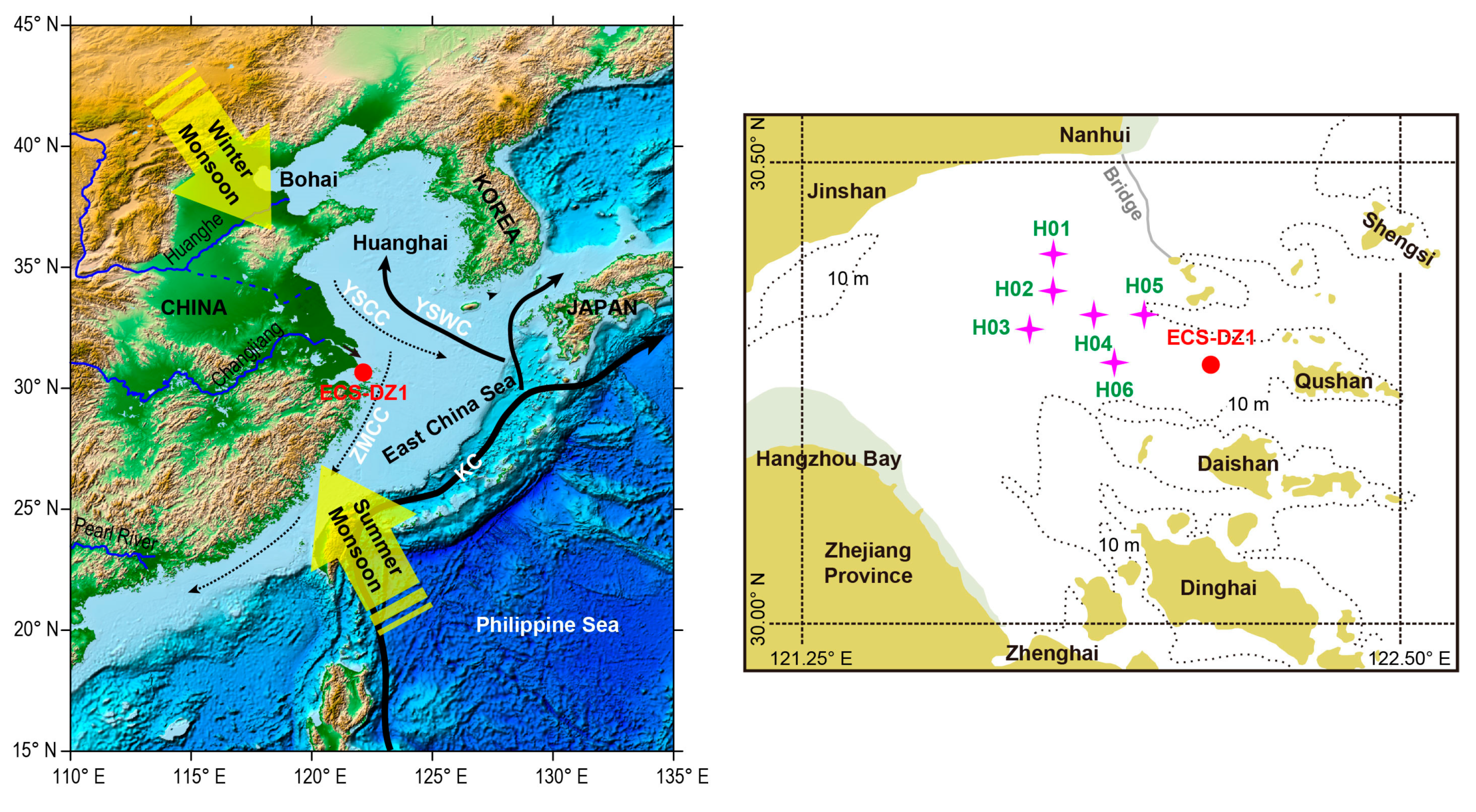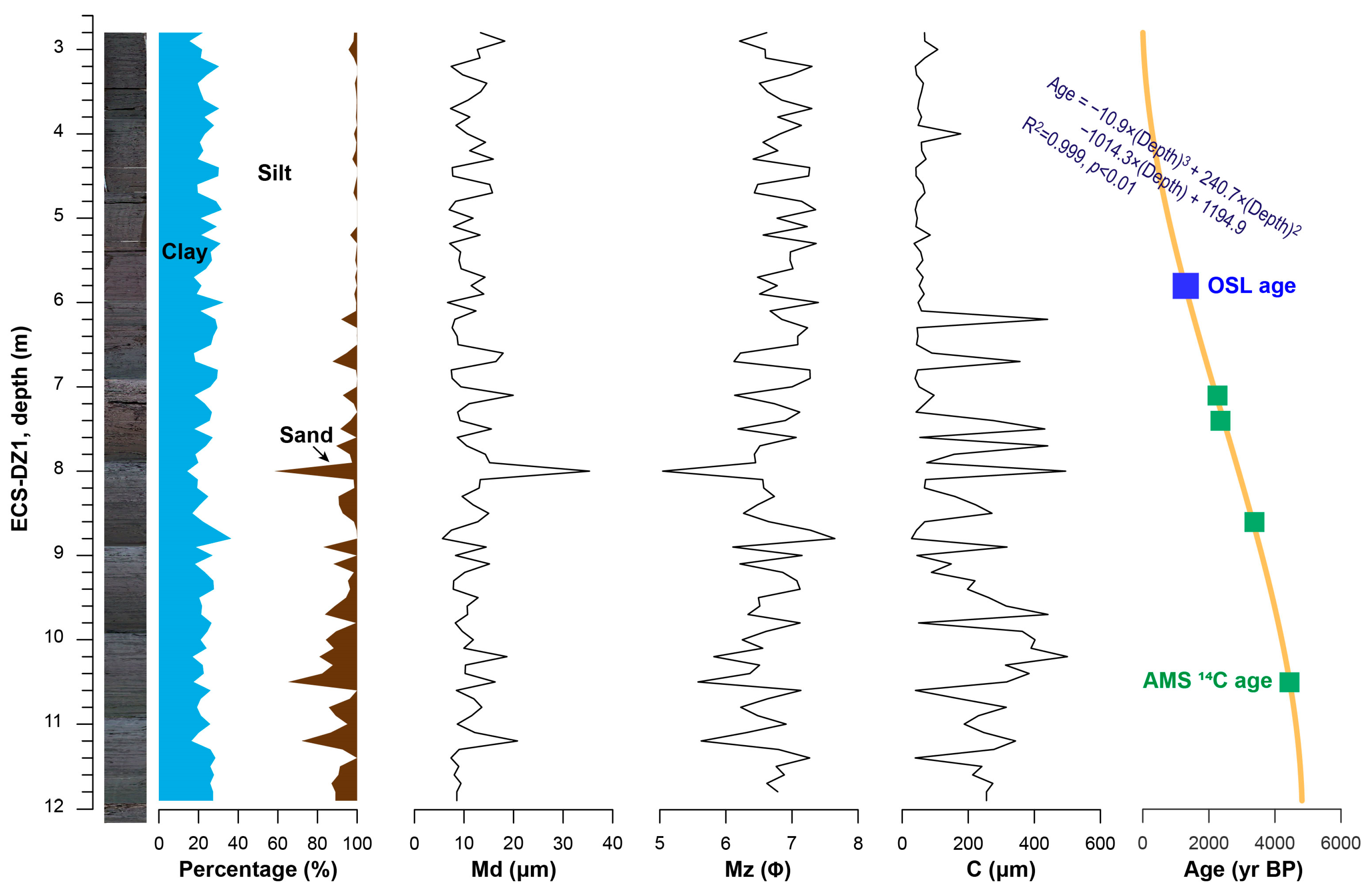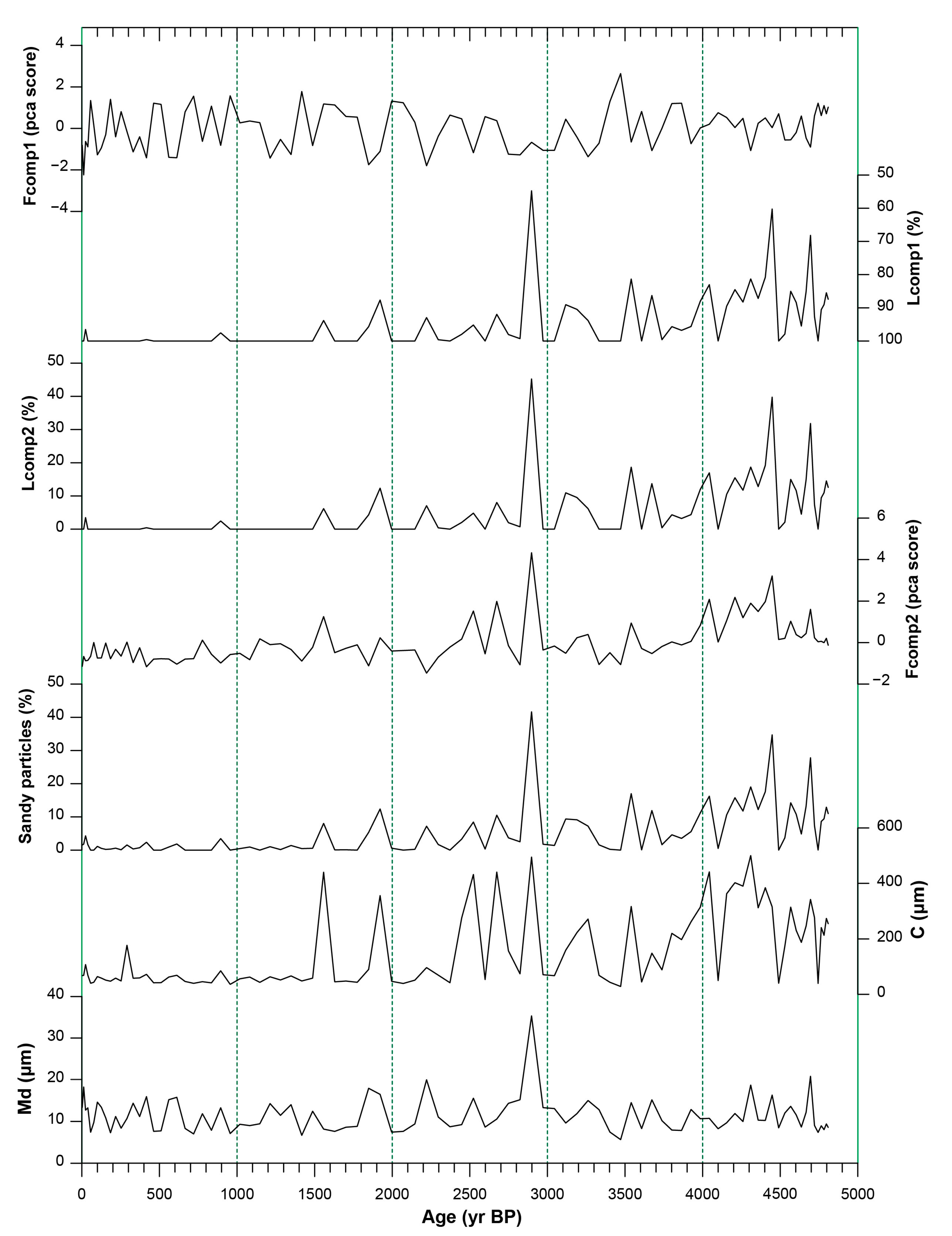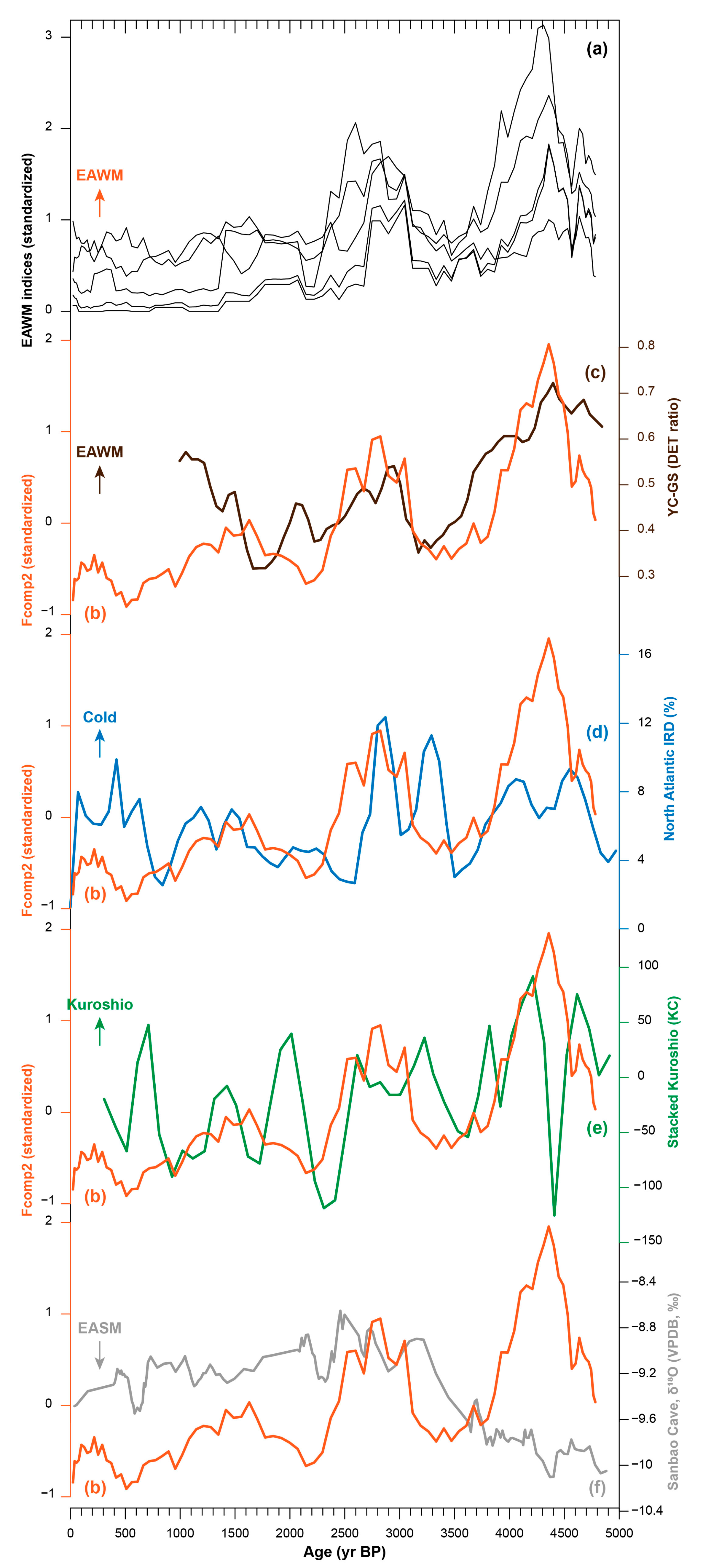A 5000-Year Sedimentary Record of East Asian Winter Monsoon from the Northern Muddy Area of the East China Sea
Abstract
1. Introduction
2. Core ECS-DZ1 and Experiments
3. Results
3.1. Age-Depth Model
3.2. Sediment Grain-Size
4. Discussion
5. Conclusions
Author Contributions
Funding
Acknowledgments
Conflicts of Interest
References
- Hu, L.M.; Lin, T.; Shi, X.F.; Yang, Z.S.; Wang, H.J.; Zhang, G.; Guo, Z.G. The role of shelf mud depositional process and large river inputs on the fate of organochlorine pesticides in sediments of the Yellow and East China seas. Geophys. Res. Lett. 2011, 38. [Google Scholar] [CrossRef]
- Wang, Y.; Cheng, H.; Edwards, R.L.; He, Y.; Kong, X.; An, Z.; Wu, J.; Kelly, M.J.; Dykoski, C.A.; Li, X. The Holocene Asian Monsoon: Links to Solar Changes and North Atlantic Climate. Science 2005, 308, 854–857. [Google Scholar] [CrossRef] [PubMed]
- Liu, J.P.; Xu, K.H.; Li, A.C.; Milliman, J.D.; Velozzi, D.M.; Xiao, S.B.; Yang, Z.S. Flux and fate of Yangtze River sediment delivered to the East China Sea. Geomorphology 2007, 85, 208–224. [Google Scholar] [CrossRef]
- Xiao, S.; Li, A.; Liu, J.P.; Chen, M.; Xie, Q.; Jiang, F.; Li, T.; Xiang, R.; Chen, Z. Coherence between solar activity and the East Asian winter monsoon variability in the past 8000 years from Yangtze River-derived mud in the East China Sea. Palaeogeogr. Palaeoclimatol. Palaeoecol. 2006, 237, 293–304. [Google Scholar] [CrossRef]
- Bian, C.; Jiang, W.; Greatbatch, R.J. An exploratory model study of sediment transport sources and deposits in the Bohai Sea, Yellow Sea, and East China Sea. J. Geophys. Res. Oceans 2013, 118, 5908–5923. [Google Scholar] [CrossRef]
- Gao, S.; Wang, D.; Yang, Y.; Zhou, L.; Zhao, Y.; Gao, W.; Han, Z.; Yu, Q.; Li, G. Holocene sedimentary systems on a broad continental shelf with abundant river input: Process–product relationships. Geol. Soc. Lond. Spec. Publ. 2016, 429, 223–259. [Google Scholar] [CrossRef]
- Qiao, S.; Shi, X.; Wang, G.; Zhou, L.; Hu, B.; Hu, L.; Yang, G.; Liu, Y.; Yao, Z.; Liu, S. Sediment accumulation and budget in the Bohai Sea, Yellow Sea and East China Sea. Mar. Geol. 2017, 390, 270–281. [Google Scholar] [CrossRef]
- Liu, J.P.; Milliman, J.D.; Gao, S.; Cheng, P. Holocene development of the Yellow River’s subaqueous delta, North Yellow Sea. Mar. Geol. 2004, 209, 45–67. [Google Scholar] [CrossRef]
- Peng, J.; Luo, X.; Liu, F.; Zhang, Z. Analysing the influences of ENSO and PDO on water discharge from the Yangtze River into the sea. Hydrol. Process. 2018, 32, 1090–1103. [Google Scholar] [CrossRef]
- Yang, Z.S.; Liu, J.P. A unique Yellow River-derived distal subaqueous delta in the Yellow Sea. Mar. Geol. 2007, 240, 169–176. [Google Scholar] [CrossRef]
- Zhang, X.; Fan, D.; Tian, Y.; Sun, Z.; Zhai, B.; Liu, M.; Chen, B.; Yang, Z. Quantitative reconstruction of the East Asian Winter Monsoon evolution over the past 100 years: Evidence from high-resolution sedimentary records of the inner continental shelf of the East China Sea. Holocene 2020, 30, 1053–1062. [Google Scholar] [CrossRef]
- Lyu, W.; Yang, J.; Fu, T.; Chen, Y.; Hu, Z.; Tang, Y.Z.; Lan, J.; Chen, G.; Su, Q.; Xu, X.; et al. Asian monsoon and oceanic circulation paced sedimentary evolution over the past 1500 years in the central mud area of the Bohai Sea, China. Geol. J. 2020, 55, 5606–5618. [Google Scholar] [CrossRef]
- Qiao, S.; Yang, Z.; Liu, J.; Sun, X.; Xiang, R.; Shi, X.; Fan, D.; Saito, Y. Records of late-Holocene East Asian winter monsoon in the East China Sea: Key grain-size component of quartz versus bulk sediments. Quat. Int. 2011, 230, 106–114. [Google Scholar] [CrossRef]
- Zhou, X.; Sun, L.; Huang, W.; Liu, Y.; Jia, N.; Cheng, W. Relationship between magnetic susceptibility and grain size of sediments in the China Seas and its implications. Cont. Shelf Res. 2014, 72, 131–137. [Google Scholar] [CrossRef]
- Zhou, X.; Sun, L.; Huang, W.; Cheng, W.; Jia, N. Precipitation in the Yellow River drainage basin and East Asian monsoon strength on a decadal time scale. Quat. Res. 2012, 78, 486–491. [Google Scholar] [CrossRef]
- Liu, X.Q. Marine Environmental Geology of China; Ocean Press: Beijing, China, 2006. [Google Scholar]
- Yuan, D.; Hsueh, Y. Dynamics of the cross-shelf circulation in the Yellow and East China Seas in winter. Deep Sea Res. Part II Top. Stud. Oceanogr. 2010, 57, 1745–1761. [Google Scholar] [CrossRef]
- Yi, L.; Ye, X.; Chen, J.; Li, Y.; Long, H.; Wang, X.; Du, J.; Zhao, S.; Deng, C. Magnetostratigraphy and luminescence dating on a sedimentary sequence from northern East China Sea: Constraints on evolutionary history of eastern marginal seas of China since the Early Pleistocene. Quat. Int. 2014, 349, 316–326. [Google Scholar] [CrossRef]
- Wang, Y.; Long, H.; Yi, L.; Yang, L.; Ye, X.; Shen, J. OSL chronology of a sedimentary sequence from the inner-shelf of the East China Sea and its implication on post-glacial deposition history. Quat. Geochronol. 2015, 30, 282–287. [Google Scholar] [CrossRef]
- Yi, L.; Yu, H.J.; Ortiz, J.D.; Xu, X.Y.; Qiang, X.K.; Huang, H.J.; Shi, X.; Deng, C.L. A reconstruction of late Pleistocene relative sea level in the south Bohai Sea, China, based on sediment grain-size analysis. Sediment. Geol. 2012, 281, 88–100. [Google Scholar] [CrossRef]
- Ma, L.; Abuduwaili, J.; Liu, W.; He, Z. Variations in Sediment Grain Size from a Lake in the Tianshan Mountain of Central Asia: Implications for Paleoprecipitation Reconstruction. Appl. Sci. 2020, 10, 6793. [Google Scholar] [CrossRef]
- Wang, C.; Chen, M.; Qi, H.; Intasen, W.; Kanchanapant, A. Grain-Size Distribution of Surface Sediments in the Chanthaburi Coast, Thailand and Implications for the Sedimentary Dynamic Environment. J. Mar. Sci. Eng. 2020, 8, 242. [Google Scholar] [CrossRef]
- Paterson, G.A.; Heslop, D. New methods for unmixing sediment grain size data. Geochem. Geophys. Geosyst. 2015, 16, 4494–4506. [Google Scholar] [CrossRef]
- Yi, L.; Yu, H.-J.; Ortiz, J.D.; Xu, X.-Y.; Chen, S.-L.; Ge, J.-Y.; Hao, Q.-Z.; Yao, J.; Shi, X.-F.; Peng, S.-Z. Late Quaternary linkage of sedimentary records to three astronomical rhythms and the Asian monsoon, inferred from a coastal borehole in the south Bohai Sea, China. Palaeogeogr. Palaeoclimatol. Palaeoecol. 2012, 329–330, 101–117. [Google Scholar] [CrossRef]
- Darby, D.A.; Ortiz, J.; Polyak, L.; Lund, S.; Jakobsson, M.; Woodgate, R.A. The role of currents and sea ice in both slowly deposited central Arctic and rapidly deposited Chukchi–Alaskan margin sediments. Glob. Planet. Chang. 2009, 68, 58–72. [Google Scholar] [CrossRef]
- Ashley, G.M. Interpretation of polymodal sediments. J. Geol. 1978, 86, 411–421. [Google Scholar] [CrossRef]
- Kranck, K.; Smith, P.C.; Milligan, T.G. Grain-size characteristics of fine-grained unflocculated sediments I: ‘one-round’ distributions. Sedimentology 1996, 43, 589–596. [Google Scholar] [CrossRef]
- Kranck, K.; Smith, P.C.; Milligan, T.G. Grain-size characteristics of fine-grained unflocculated sediments II:’milti-round’ distributions. Sedimentology 1996, 43, 597–606. [Google Scholar] [CrossRef]
- Påsse, T. Grain size distribution expressed as tanh-functions. Sedimentology 1997, 44, 1011–1014. [Google Scholar] [CrossRef]
- Weltje, G.J. End-member modeling of compositional data: Numerical-statistical algorithms for solving the explicit mixing problem. Math. Geol. 1997, 29, 503–549. [Google Scholar] [CrossRef]
- Chen, H.; Zhu, L.; Ju, J.; Wang, J.; Ma, Q. Temporal variability of 14C reservoir effects and sedimentological chronology analysis in lake sediments from Chibuzhang Co, North Tibet (China). Quat. Geochronol. 2019, 52, 88–102. [Google Scholar] [CrossRef]
- Anderson, J.B.; Conway, H.; Bart, P.J.; Witus, A.E.; Greenwood, S.L.; McKay, R.M.; Hall, B.L.; Ackert, R.P.; Licht, K.; Jakobsson, M.; et al. Ross Sea paleo-ice sheet drainage and deglacial history during and since the LGM. Quat. Sci. Rev. 2014, 100, 31–54. [Google Scholar] [CrossRef]
- Xiao, J.; Si, B.; Zhai, D.; Itoh, S.; Lomtatidze, Z. Hydrology of Dali Lake in central-eastern Inner Mongolia and Holocene East Asian monsoon variability. J. Paleolimnol. 2008, 40, 519–528. [Google Scholar] [CrossRef]
- Passega, R. Texture as characteristic of clastic deposition. AAPG Bull. 1957, 41, 1952–1984. [Google Scholar]
- Passega, R. Grain size representation by CM patterns as a geologic tool. J. Sediment. Res. 1964, 34, 830–847. [Google Scholar] [CrossRef]
- Ren, R.; Chen, S.; Dong, P.; Liu, F. Spatial and Temporal Variations in Grain Size of Surface Sediments in the Littoral Area of Yellow River Delta. J. Coast. Res. 2012, 28, 44–53. [Google Scholar] [CrossRef]
- Li, Y.; Yu, H.; Yi, L.; Su, Q.; Hu, K.; Xu, X.; Wang, J. Grain-size characteristics and its sedimentary significance of coastal sediments of the borehole Lz908 in the south Bohai Sea (the Laizhou Bay), China. Mar. Sci. 2014, 38, 107–113. [Google Scholar]
- Zhang, L.; Chen, S.; Pan, S.; Yi, L.; Jiang, C. Sediment variability and transport in the littoral area of the abandoned Yellow River Delta, northern Jiangsu. J. Geogr. Sci. 2014, 24, 717–730. [Google Scholar] [CrossRef]
- Li, Y.; Morrill, C. A Holocene East Asian winter monsoon record at the southern edge of the Gobi Desert and its comparison with a transient simulation. Clim. Dyn. 2015, 45, 1219–1234. [Google Scholar] [CrossRef]
- Han, W.; Lü, S.; Appel, E.; Berger, A.; Madsen, D.; Vandenberghe, J.; Yu, L.; Han, Y.; Yang, Y.; Zhang, T.; et al. Dust Storm Outbreak in Central Asia After ~3.5 kyr BP. Geophys. Res. Lett. 2019, 46, 7624–7633. [Google Scholar] [CrossRef]
- Bond, G.; Kromer, B.; Beer, J.; Muscheler, R.; Evans, M.N.; Showers, W.; Hoffmann, S.; Lotti-Bond, R.; Hajdas, I.; Bonani, G. Persistent Solar Influence on North Atlantic Climate During the Holocene. Science 2001, 294, 2130–2136. [Google Scholar] [CrossRef]
- Jian, Z.; Wang, P.; Saito, Y.; Wang, J.; Pflaumann, U.; Oba, T.; Cheng, X. Holocene variability of the Kuroshio Current in the Okinawa Trough, northwestern Pacific Ocean. Earth Planet. Sci. Lett. 2000, 184, 305–319. [Google Scholar] [CrossRef]
- Cheng, H.; Edwards, R.L.; Sinha, A.; Spötl, C.; Yi, L.; Chen, S.; Kelly, M.; Kathayat, G.; Wang, X.; Li, X.; et al. The Asian monsoon over the past 640,000 years and ice age terminations. Nature 2016, 534, 640–646. [Google Scholar] [CrossRef] [PubMed]
- Bond, G.; Showers, W.; Cheseby, M.; Lotti, R.; Almasi, P.; deMenocal, P.; Priore, P.; Cullen, H.; Hajdas, I.; Bonani, G. A Pervasive Millennial-Scale Cycle in North Atlantic Holocene and Glacial Climates. Science 1997, 278, 1257–1266. [Google Scholar] [CrossRef]
- Yi, L.; Chen, S.; Ortiz, J.D.; Chen, G.; Peng, J.; Liu, F.; Chen, Y.; Deng, C. 1500-year cycle dominated Holocene dynamics of the Yellow River delta, China. Holocene 2016, 26, 222–234. [Google Scholar] [CrossRef]
- Liu, Y.H.; Henderson, G.M.; Hu, C.Y.; Mason, A.J.; Charnley, N.; Johnson, K.R.; Xie, S.C. Links between the East Asian monsoon and North Atlantic climate during the 8,200 year event. Nat. Geosci. 2013, 6, 117–120. [Google Scholar] [CrossRef]
- Liu, D.; Wang, Y.; Cheng, H.; Edwards, R.L.; Kong, X.; Chen, S.; Liu, S. Contrasting Patterns in Abrupt Asian Summer Monsoon Changes in the Last Glacial Period and the Holocene. Paleoceanogr. Paleoclimatol. 2018, 33, 214–226. [Google Scholar] [CrossRef]
- Talley, L.D. Closure of the Global Overturning Circulation Through the Indian, Pacific, and Southern Oceans: Schematics and Transports. Oceanography 2013, 26, 80–97. [Google Scholar] [CrossRef]
- Hsueh, Y.; Schultz, J.R.; Holland, W.R. The Kuroshio flow-through in the East China Sea: A numerical model. Prog. Oceanogr. 1997, 39, 79–108. [Google Scholar] [CrossRef]
- Sun, Y.; Clemens, S.C.; Morrill, C.; Lin, X.; Wang, X.; An, Z. Influence of Atlantic meridional overturning circulation on the East Asian winter monsoon. Nat. Geosci. 2012, 5, 46–49. [Google Scholar] [CrossRef]
- Stevens, T.; Thomas, D.S.G.; Armitage, S.J.; Lunn, H.R.; Lu, H. Reinterpreting climate proxy records from late Quaternary Chinese loess: A detailed OSL investigation. Earth Sci. Rev. 2007, 80, 111–136. [Google Scholar] [CrossRef]
- Xiang, R.; Yang, Z.; Saito, Y.; Guo, Z.; Fan, D.; Li, Y.; Xiao, S.; Shi, X.; Chen, M. East Asia Winter Monsoon changes inferred from environmentally sensitive grain-size component records during the last 2300 years in mud area southwest off Cheju Island, ECS. Sci. China Ser. D 2006, 49, 604–614. [Google Scholar] [CrossRef]
- Steinke, S.; Glatz, C.; Mohtadi, M.; Groeneveld, J.; Li, Q.; Jian, Z. Past dynamics of the East Asian monsoon: No inverse behaviour between the summer and winter monsoon during the Holocene. Glob. Planet. Chang. 2011, 78, 170–177. [Google Scholar] [CrossRef]
- Yancheva, G.; Nowaczyk, N.R.; Mingram, J.; Dulski, P.; Schettler, G.; Negendank, J.F.W.; Liu, J.; Sigman, D.M.; Peterson, L.C.; Haug, G.H. Influence of the intertropical convergence zone on the East Asian monsoon. Nature 2007, 445, 74–77. [Google Scholar] [CrossRef] [PubMed]
- Xiao, J.; Nakamura, T.; Lu, H.; Zhang, G. Holocene climate changes over the desert/loess transition of north-central China. Earth Planet. Sci. Lett. 2002, 197, 11–18. [Google Scholar] [CrossRef]
- Ge, Q.; Xue, Z.; Yao, Z.; Zang, Z.; Chu, F. Anti-phase relationship between the East Asian winter monsoon and summer monsoon during the Holocene? J. Ocean Univ. China 2017, 16, 175–183. [Google Scholar] [CrossRef]
- Hu, B.; Yang, Z.; Zhao, M.; Saito, Y.; Fan, D.; Wang, L. Grain size records reveal variability of the East Asian Winter Monsoon since the Middle Holocene in the Central Yellow Sea mud area, China. Sci. China Earth Sci. 2012, 55, 1656–1668. [Google Scholar] [CrossRef]
- Kang, S.; Du, J.; Wang, N.; Dong, J.; Wang, D.; Wang, X.; Qiang, X.; Song, Y. Early Holocene weakening and mid- to late Holocene strengthening of the East Asian winter monsoon. Geology 2020, 48, 1043–1047. [Google Scholar] [CrossRef]





| Lab No. | Depth (m) | Conventional Age ± Error (y BP) | Reservoir Effect (Years) | Calibrated Age (cal y BP) |
|---|---|---|---|---|
| 375,194 | 7.1 | 4760 ± 30 | 2021 ± 95 | 1841–2246 |
| 375,193 | 7.4 | 4850 ± 30 | 4477 ± 106 | 4244–4713 |
| 375,195 | 8.6 | 5880 ± 30 | 5106 ± 116 | 4879–5290 |
| 375,196 | 10.5 | 6940 ± 40 | 6448 ± 90 | 6289–6621 |
| 1 NL-291 | 5.8 | 1300 ± 200 | - | - |
| Component | Initial Eigenvalues/Extraction Sums of Squared Loadings | ||
|---|---|---|---|
| Total | % of Variance | Cumulative % | |
| Fcomp1 | 46.71 | 48.65 | 48.65 |
| Fcomp2 | 26.30 | 27.40 | 76.05 |
| Fcomp3 | 12.30 | 12.81 | 88.86 |
| …. | …. | …. | …. |
Publisher’s Note: MDPI stays neutral with regard to jurisdictional claims in published maps and institutional affiliations. |
© 2020 by the authors. Licensee MDPI, Basel, Switzerland. This article is an open access article distributed under the terms and conditions of the Creative Commons Attribution (CC BY) license (http://creativecommons.org/licenses/by/4.0/).
Share and Cite
Chen, Y.; Li, Y.; Lyu, W.; Xu, D.; Han, X.; Fu, T.; Yi, L. A 5000-Year Sedimentary Record of East Asian Winter Monsoon from the Northern Muddy Area of the East China Sea. Atmosphere 2020, 11, 1376. https://doi.org/10.3390/atmos11121376
Chen Y, Li Y, Lyu W, Xu D, Han X, Fu T, Yi L. A 5000-Year Sedimentary Record of East Asian Winter Monsoon from the Northern Muddy Area of the East China Sea. Atmosphere. 2020; 11(12):1376. https://doi.org/10.3390/atmos11121376
Chicago/Turabian StyleChen, Yanping, Yan Li, Wenzhe Lyu, Dong Xu, Xibin Han, Tengfei Fu, and Liang Yi. 2020. "A 5000-Year Sedimentary Record of East Asian Winter Monsoon from the Northern Muddy Area of the East China Sea" Atmosphere 11, no. 12: 1376. https://doi.org/10.3390/atmos11121376
APA StyleChen, Y., Li, Y., Lyu, W., Xu, D., Han, X., Fu, T., & Yi, L. (2020). A 5000-Year Sedimentary Record of East Asian Winter Monsoon from the Northern Muddy Area of the East China Sea. Atmosphere, 11(12), 1376. https://doi.org/10.3390/atmos11121376







